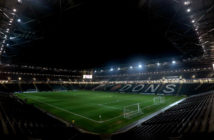
La Bombonera (the chocolate box) is the home to Boca Juniors
Clasico Weekend in Buenos Aires
I flew 20 hours each way from the UK to Argentina to watch four football matches in two days.
I arrived on Friday and left on Monday
But this was no ordinary weekend, this was derby weekend in Argentina, or as they call derbies in Spanish, a Clasico weekend.
The problem in organizing this trip was that the Argentinean football league doesn’t confirm the exact dates of fixtures until 10 days beforehand (they spread the league matches out across Friday Saturday, Sunday and Monday) and then the kick off times are only confirmed seven days in advance. Thus, I took a gamble a couple of months ago when I noticed this last weekend in April would be Clasico weekend, and booked the flights in the hope that I could see several of the biggest derbies in world football.
Unfortunately, when the fixtures were confirmed there was no chance to see the Rosario Clasico (Newell’s Old Boys v Rosario Central) in the city where Messi was born (3 hours drive north of Buenos Aires) unless I sacrificed two of the world’s most famous derbies, including what is known as Super Clasico (Boca Juniors v River Plate).
Despite the lack of away fans attending the matches (Argentina banned them in the league three years ago after a series of serious problems involving the deaths of several fans) I was very much looking forward to this adventure as Argentinian football is notorious around the world for its passionate and colorful fans.
Buenos Aires and the surrounding urban sprawl contains 13 million people (1/3 of the country’s total population) and boasts a significant number of large clubs.

San Lorenzo is famously supported by Pope Francis
Clasico 1 – Saturday 23 April: San Lorenzo v Huracán (kick-off 16:15) (Crowd: 35,000 )
I hopped on a local bus and set off for San Lorenzo in the western suburbs of Buenos Aires with the warning from some locals that this was not a very safe part of town to be in. Upon arriving, you could certainly see the poverty in the streets around the stadium, but with the presence of numerous riot police, I didn’t feel particularly uncomfortable. Inside the stadium I was greeted to the sound of drums and singing from 35,000 passionate San Lorenzo fans. On a fine sunny autumn’s day I enjoyed a one-nil home victory. I didn’t hang about though as I had another Clasico to get to.
Clasico 2 – Saturday 23 April: Gimnasia La Plata v Estudiantes (kick-off 20:45) (Crowd: 21,000 )
My challenge was to get myself 40 miles south to the town of La Plata (a 1.5 hour drive south of Buenos Aires). The problem was that it was about 18:15 and there was no sign of any taxis around the stadium and my next match was due to start at 20:45. I decided to start walking away from the stadium – and the hoards of exiting fans – thinking this may increase my chances of finding a taxi. It was, however, also increasing my chances of venturing into parts of the area that could be dangerous and away from the reassurance that riot police to ward off any would-be opportunists.
After walking for about fifteen minutes I finally found a taxi and explained to the driver that I wished to go to La Plata. He obviously seemed a bit confused as no doubt he wasn’t expecting such a long trip. I showed him on my Mobile phone on Google Maps and he finally understood and agreed to the trip.
I arrived on time for Clasico number two of the weekend at Gimnasia La Plata’s stadium. Gimnasia is the oldest football club in South America, which was founded in 1887, ahead of more world renowned clubs such as Barcelona (1899), Real Madrid (1902), Liverpool (1892) and Glasgow Celtic (1888).
After a fairly uneventful nil-nil match I left the stadium and hitch-hiked my way back to the centre of La Plata to catch a bus back north to the capital. The contrast in price to my taxi was quite stark: 800 pesos for the taxi (equivalent to $55) compared to the bus which cost me 22 pesos (equivalent to $1.50)!

Clasico 3 – Sunday 24 April: Boca Juniors v River Plate (kick-off 16:15) (Crowd: 49,000 )
There are numerous “50 sporting events to see before you die” guides that recommend watching the Super Clasico between arch-rivals Boca Juniors (from one of the poorest parts of town) and River Plate (from the more affluent part). And here I was at the Bombonera stadium (which translates as the chocolate box in Spanish due to its shape) to witness the very striking and colorful blue and yellow of the Boca fans. The story goes that when deciding on what colors their club should play in, they agreed to go with the colors of the flag of the next boat to sail into the harbor (which is close by to the stadium) – a Swedish boat duly arrived and the rest is history.
Boca went down to ten men early on after Perez was sent off after kicking-out at a River player who had committed a late challenge on the Boca keeper. There wasn’t too much else during the match to report on and the outcome again was a nil-nil draw. However, most of the action was taking place off the pitch and it really is a truly unique experience to watch the Boca fans singing during the entire match accompanied by numerous drums and trumpets.
Clasico 4 – Sunday 24 April: Racing Club v Independiente (kick-off 18:45) (Crowd: 45,000 )
Googlemaps says it was a 13 minute drive from Boca’s stadium to Racing Club’s stadium, across the river. I wasn’t placing too much reliance on this estimate given that I would be battling my way through a traffic jam of 50,000 fans making their way home after the match. Nevertheless, after finding a taxi very quickly and leaving Boca’s stadium at 18:15, I made it to Racing’s stadium in twelve minutes, arriving just before 18:30 in time for my final Clasico of the weekend between Racing Club and Independiente.
Surely, odds were I was going to see some goals this time. Nope. It was another nil-nil bore draw. Still, the atmosphere was incredible, once again.
I can only wonder what it would have been like to watch these Clasicos with goals and with away fans present.
Perhaps, next time.
Mark Szczuka is an international correspondent for Prost Amerika.
![Prost International [PINT]](https://prostinternational.com/wp-content/uploads/2021/08/PINTtFontLogoRoboto1536x78.jpg)


